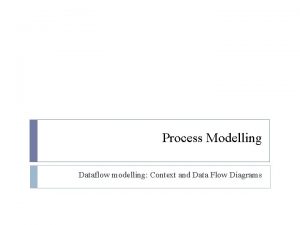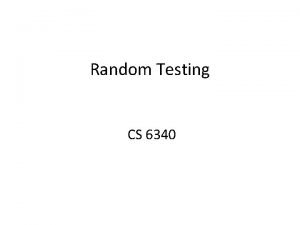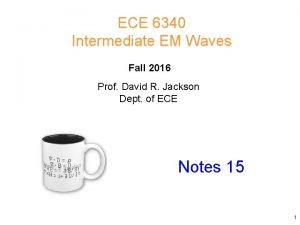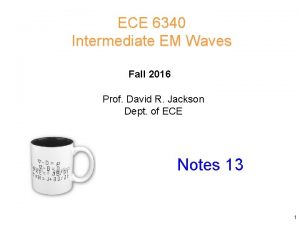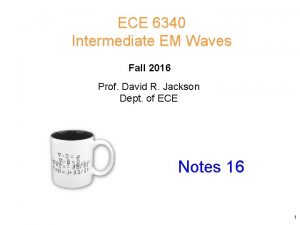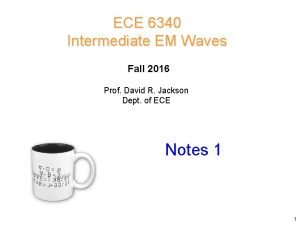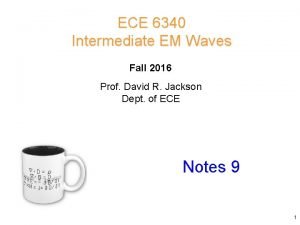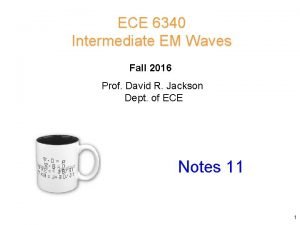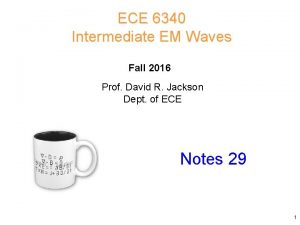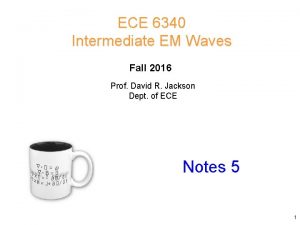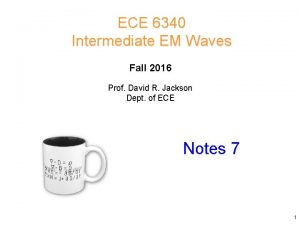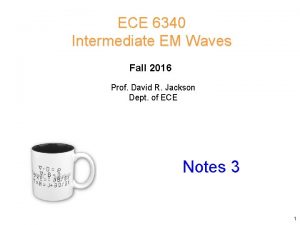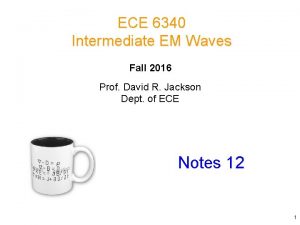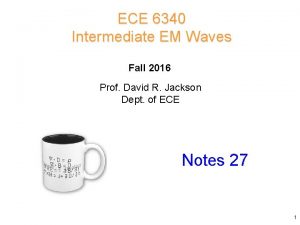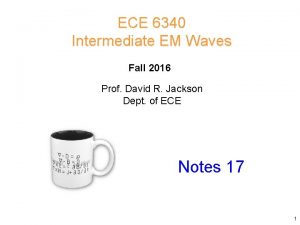ECE 6340 Intermediate EM Waves Fall 2016 Prof

















- Slides: 17

ECE 6340 Intermediate EM Waves Fall 2016 Prof. David R. Jackson Dept. of ECE Notes 19 1

Critical Angle Assume lossless materials i n 1 y t n 2 z Snell’s law: 2

Critical Angle At the critical angle ( i = c): t = 90 o so c n 1 y t n 2 z 3

Critical Angle Notes: § The critical angle applies to any polarization. § The critical angle is only defined for lossless materials. § A critical angle exists only when going from a higher to a lower density medium (n 1 > n 2 ). 4

Beyond Critical Angle Let’s examine the transmitted angle: Assume so 5

Beyond Critical Angle (cont. ) Note: The power flow in the upper region is horizontal. No power crosses the boundary Region 1 Power flow y Region 2 z Note: The power flow in the lower region is horizontal, and decays with z. 6

Beyond Critical Angle (cont. ) All of the incident power is reflected 7

Beyond Critical Angle (cont. ) Determine the transmitted angle t : Let (real) Use or must use +sign Not possible 8

Beyond Critical Angle (cont. ) Hence 9

Beyond Critical Angle (cont. ) Choose + sign to obtain correct value for kz 2 : The + sign is chosen to obtain a decaying wave. 10

Beyond Critical Angle (cont. ) Hence Practical note: When dealing with inhomogeneous plane waves (complex angles), it is usually easier to avoid working with angles and use the separation equation instead. Requires complex angle Does not requires complex angle 11

Brewster Angle TMz No reflection Ei n 1 y tb Lossless materials n 2 z 12

Brewster Angle (cont. ) Perfect match: 13

Brewster Angle (cont. ) Assume m 1 = m 2 = m : 14

Brewster Angle (cont. ) b Hence 15

Brewster Angle (cont. ) Notes: § For non-magnetic media, only the TMz polarization has a Brewster angle. § A Brewster angle exists for any material contrast ratio. 16

Brewster Angle (cont. ) From Snell's law: tb b This means that tb is the angle shown in this figure. Hence The reflected and transmitted k vectors are perpendicular. 17
 Dfd 6340
Dfd 6340 Cs 6340
Cs 6340 Similarities of mechanical waves and electromagnetic waves
Similarities of mechanical waves and electromagnetic waves Light waves are transverse waves true or false
Light waves are transverse waves true or false Venn diagram mechanical and electromagnetic waves
Venn diagram mechanical and electromagnetic waves Mechanical waves and electromagnetic waves similarities
Mechanical waves and electromagnetic waves similarities Characteristics of a longitudinal wave
Characteristics of a longitudinal wave Is echolocation transverse or longitudinal
Is echolocation transverse or longitudinal Long waves and short waves
Long waves and short waves Difference between matter waves and electromagnetic waves
Difference between matter waves and electromagnetic waves Mechanical waves vs electromagnetic waves
Mechanical waves vs electromagnetic waves Similarities of mechanical and electromagnetic waves
Similarities of mechanical and electromagnetic waves Seismic waves
Seismic waves Is a seismic wave mechanical or electromagnetic
Is a seismic wave mechanical or electromagnetic Compare and contrast p waves and s waves using venn diagram
Compare and contrast p waves and s waves using venn diagram What do all waves transmit
What do all waves transmit What are constructive waves
What are constructive waves Free fall 2016
Free fall 2016
